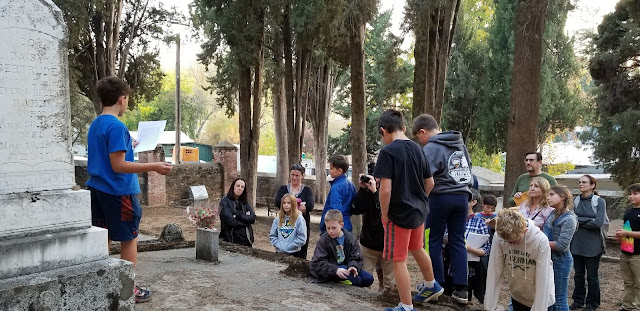First, let me apologize for the long-delayed post. We have been learningabout how the Ashkenazi Jews migrated from Jerusalem to Europe, and the customs, foods and music they created along the way. The class has enjoyed watching Fiddler on the Roof, which is a nostalgic snapshot of life in an Ashkenazi shtetel. They have been taking note of the Ashkenazi traditions that have fallen by the wayside (like using a matchmaker) and the ones that we still carry on in Reform Judaism today (like lighting Shabbat candles at sundown on Friday nights, going to religious school and getting married under a chuppah). We hope to finish watching the film before going off to winter break.
"Jews in the Gold Rush" Trip
In preparation for our upcoming unit on the Great Migration and the influence of Jewish culture on American music and culture, Shiraniks and their parents joined the other 5th and 6th grade classes on a field trip to the gold rush town of Columbia, with a stop at the Jewish cemetery in Sonora on the way home. We learned a great deal about how the Jews contributed to California's historic gold rush, and the students enjoyed getting a taste of life back in the mid 1800's. Charna came back to JQuest for this special event, which she has organized for many years. While on the bus, we tried to ignore the smoky skies outside while we watched a film about the Jews of early California. Then, after stopping for a quick lunch in Sonora, we met with the docents of Columbia
Charna led us in activities while we rode the bus to Columbia. We learned about the many Jewish families who helped to "build" California in the 19th century. Erin led us in singing some songs (both Jewish and non-Jewish) of the era.
The quaint town of Sonora still has its Gold Rush character.
Columbia State Historic Park is where we spent the bulk of the day. Docents led us on tours (one for boys, one for girls) of the town, its Jewish landmarks and the school on the hill, where the students got a healthy dose of what a school day was like during the gold rush.
During the Gold Rush, people from all over the world converged on Columbia, bringing with them their own coinage. Each denomination was given a value compared to a dollar's worth on any given day. However, since small coins were in short order, the miners and merchants would cut their American silver dollars into eight segments, or "bits," each worth 12 1/2 cents. This is where we get the term "two bits" for a quarter!

At the dentist's office, we all agreed that we are happy to live during a time when dentist's tools are much less scary!
One of the docents pointed out the Jewish shops and gathering places in town.


The headmaster of the school was a tough teacher!
Dunce??!! I should say not! (More like a very
good sport!)

The stagecoach came into town every hour or so!


After leaving Columbia, we made a stop at the oldest surviving Jewish cemetery on the west coast, in Sonora, California. The students learned the history of the cemetery, and the important role it played in the life of Jews living in the foothills of California in the 1800's and early 1900's.
The cypress trees date to the late 1800's
Charna led us in a "treasure hunt" activity.
Before arriving at the cemetery, the students learned about the individuals buried there. Each student wrote a letter in the voice of one of the interred, and we read them aloud to the class once we were able to visit each gravesite.
































No comments:
Post a Comment